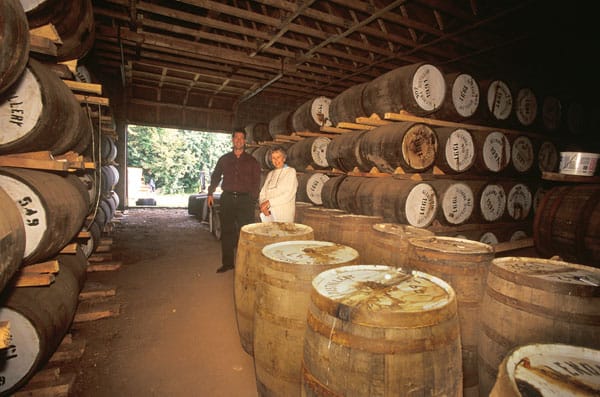If patience is the ultimate virtue, single malt is the ultimate taste.
Just as all sacred cows can meet up with a little bull, Cape Breton's Glenora Distillery puts old beliefs to rest with its Cape Breton Rare single malt whisky. According to connoisseurs of fine scotch, some of who had formerly believed that such distilled success could be achieved only in Scotland, the whisky produced in this Gaelic part of New Scotland rivals the best of the Auld Country.
Not yet in the age bracket of the finest malt scotches, this unique baby, born in the Glenville valley and nurtured by the mystical waters of MacLellan's Brook, is being weaned annually into 30,000 bottles of a rare and already sought-after malt whisky, with the promise of even greater things to come.
One might wonder about the wizardry that led to the eventual complex process of turning the lowly barley grain into a fine whisky. Obscurity blocks the view, and whether the wizard was Scottish or Irish remains a (contentious) mystery. What is known is that the origins of the "water of life" were Gaelic. To most people, the origin doesn't much matter, so long as the end result is a mellow distillation of a smooth and subtly smoky liquor served neat in a fine crystal glass following a satisfying meal.
Yes, it's a long wait for the product to become ready for consumption. And the early years were tough years for the original owner, and another who managed to stay with it for three years before running out of money. It was then that a group of businessmen, headed by Lauchie MacLean of Halifax picked it up, and, with the resources to finish out the eight-year wait, drew off the first batch of Glen Breton Rare whisky in November 2000.
What then, one wonders, is the mystery that regulates each delicate step along the way, from the mashing of the pre-soaked and sprouted barley to the maturing process.

First, let's get the name right. This is whisky, without the "e" that identifies the Irish, American and Canadian liquors made largely from rye. But it can't legally be called Scotch, which sources its manufacture only to Scotland.
With just three ingredients-barley, water, and yeast, needed to produce this spiritual beverage, it goes without saying that the trio must be of the best quality-with not a little credit given to the peat smoke, atmosphere, surroundings and location of its birth.
We begin with the barley. With six centuries of practice behind them, the Scots know their barley. For this reason, Glenora looks to Scotland to grow, harvest, and soak the grain until it sprouts. After germination (which changes the starches to the sugars that make the alcohol) the barley is dried over a peat fire, absorbing just the right amount of flavour and aroma of the peat. It is only then that the barley is shipped to Glenora and the next steps are taken.
But why not Canadian-grown barley?
According to Glenora master distiller, Daniel MacLean, it isn't so much the barley but the peat smoke that provides the flavour of a good whisky.
"Canada doesn't have peat. But we're testing a batch with Canadian barley to see if we like it. It was started in 1996, and will come off in 2005," he said.
Then, there's the water. Cape Breton's contribution to this fine whisky is the pure spring water of MacLellan's Brook, which absorbs the sweetness of the maples and the fruit of the apple trees that surround it.
"The water is undisturbed and there's lots of it," says MacLean. "It's not polluted. It's natural, spring water. It's not hill water; it springs up from the ground from hundreds of little springs."
In front of the clean, whitewashed walls of the distillery is a holding pond which, when full, contains one million litres of water. This is not the water that goes into the whisky. Fifty thousand gallons of it is pumped in daily for cooling the pipes through which the distilling fluid flows.
"Liquor will burn if it's too hot, and while 20 degrees Celsius is the base temperature, I like to keep it at seven Celsius," MacLean says.

The third ingredient required for making a single malt whisky is the brewers' yeast that breaks down the sugars and changes them into alcohol. It takes about 48 hours of fermentation to arrive at nine per cent alcohol, so it has a long way to go before reaching the desired 35 to 40 per cent alcohol content.
So, basically, the process which starts in the mash house where the sugar-water mixture, called the wort, is produced, moves the raw liquid through a heat exchanger to cool it, and then into huge wooden tubs, called washbacks, to ferment. From there it goes into the first of two wash stills, where it is heated to 80 degrees Celsius. The steam so generated is collected and condensed. This, then, is the whisky that must be measured for volume and alcohol content before it flows on into the spirit still where it goes through a second distillation. Everything is repeated until the liquid reaches the final spirit receiver. And, there it waits to be transferred to bourbon-soaked oak barrels and stored in the warehouses for aging.
"Bourbon barrels are used only once in order to get the best out of the barrel. They're used only once before Glenora gets them, as well," MacLean says.
In the warehouse, which is situated far from the parking lot so as not to be impacted by car exhaust, the barrels are stacked in such a way that they can breathe.
Because fumes rise, the whisky in the top barrels develops a darker colour; but since 100 barrels are dumped together to "marry" with each other before bottling, it matters not.
From those 100 barrels, 2,500 to 3,000 cases of nine-year-old whisky are bottled each year. Since each of the 12 bottles in those cases sells for $75, it's easy to do the arithmetic (but don't forget the tax factor). But, there are no plans to expand production at this point.
"We plan to keep it that way. Rare and pricey," MacLean says.
With the production season operating only during the cold months, from September through February, the facility still costs $5,000 a day to run. So, what keeps it going the rest of the year?
That's when tourism kicks in. An on-site nine-room luxury inn and six chalets enjoy high occupancy during the summer and fall, and an upscale, 48-seat dining room, with Executive Chef Steve Moir in charge, is full most days. Any spillovers, or preferences for lighter meals, can be accommodated in the adjoining pub, where the knowledgeable bartender and whisky aficionado Donnie Campbell keeps his customers happy. Whisky devotees love the stools where they can sit and chat with Campbell. And most stay over to take the guided tour of the distillery the next day.
In addition to master distiller MacLean, there are four men involved in the whisky-making. Mike MacLeod runs the mash house; Angus Hubbard manages the still house, while Murdock Matheson and Bobby MacDonald are maintenance men who keep things running.
Although it will obviously be some considerable time before Glenora's product could reach the age of Scotland's prestigious 12 or 18-year-olds, Glen Breton Rare single malt whisky can, according to its faithful connoisseurs, rank right up there with the best.
"We've had comments that our nine-year-old tastes as good as some of the twelve-year-olds. We're proud of that," MacLean says.
The whisky distilled at Glenora is called simply Glen Breton Rare single malt whisky, and it has the distinction of being the first, and only successful single malt whisky produced in North America.
But Angus Hubbard has his own name for it. "I call it 'Canada's Only'," he states proudly.
